2014 BMW M235I tire pressure
[x] Cancel search: tire pressurePage 151 of 218
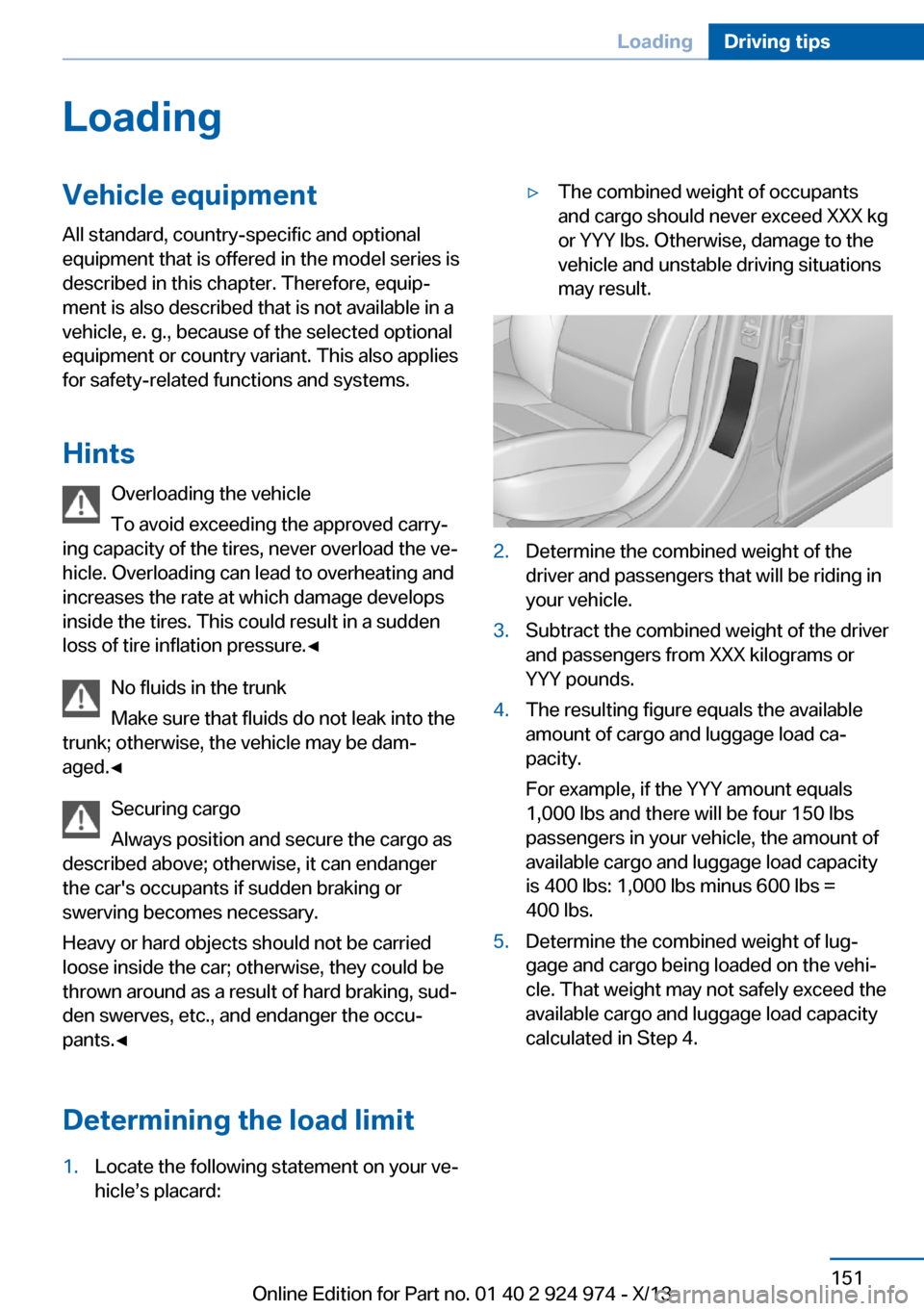
LoadingVehicle equipment
All standard, country-specific and optional
equipment that is offered in the model series is
described in this chapter. Therefore, equip‐
ment is also described that is not available in a
vehicle, e. g., because of the selected optional
equipment or country variant. This also applies
for safety-related functions and systems.
Hints Overloading the vehicle
To avoid exceeding the approved carry‐
ing capacity of the tires, never overload the ve‐
hicle. Overloading can lead to overheating and
increases the rate at which damage develops
inside the tires. This could result in a sudden
loss of tire inflation pressure.◀
No fluids in the trunk
Make sure that fluids do not leak into the
trunk; otherwise, the vehicle may be dam‐
aged.◀
Securing cargo
Always position and secure the cargo as
described above; otherwise, it can endanger
the car's occupants if sudden braking or
swerving becomes necessary.
Heavy or hard objects should not be carried
loose inside the car; otherwise, they could be
thrown around as a result of hard braking, sud‐
den swerves, etc., and endanger the occu‐
pants.◀
Determining the load limit1.Locate the following statement on your ve‐
hicle’s placard:▷The combined weight of occupants
and cargo should never exceed XXX kg
or YYY lbs. Otherwise, damage to the
vehicle and unstable driving situations
may result.2.Determine the combined weight of the
driver and passengers that will be riding in
your vehicle.3.Subtract the combined weight of the driver
and passengers from XXX kilograms or
YYY pounds.4.The resulting figure equals the available
amount of cargo and luggage load ca‐
pacity.
For example, if the YYY amount equals
1,000 lbs and there will be four 150 lbs
passengers in your vehicle, the amount of
available cargo and luggage load capacity
is 400 lbs: 1,000 lbs minus 600 lbs =
400 lbs.5.Determine the combined weight of lug‐
gage and cargo being loaded on the vehi‐
cle. That weight may not safely exceed the
available cargo and luggage load capacity
calculated in Step 4.Seite 151LoadingDriving tips151
Online Edition for Part no. 01 40 2 924 974 - X/13
Page 154 of 218
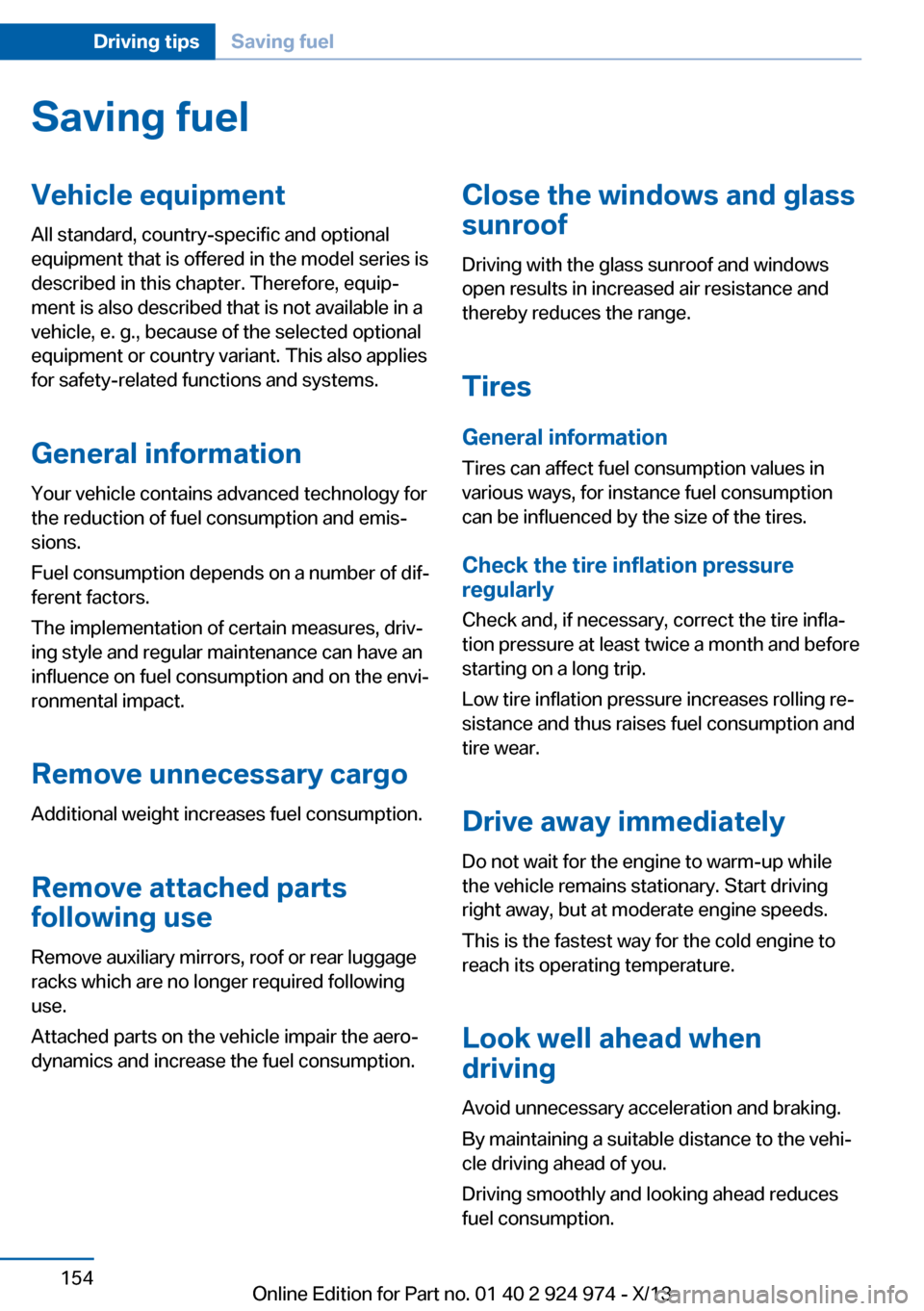
Saving fuelVehicle equipmentAll standard, country-specific and optional
equipment that is offered in the model series is
described in this chapter. Therefore, equip‐
ment is also described that is not available in a
vehicle, e. g., because of the selected optional
equipment or country variant. This also applies
for safety-related functions and systems.
General information Your vehicle contains advanced technology for
the reduction of fuel consumption and emis‐
sions.
Fuel consumption depends on a number of dif‐
ferent factors.
The implementation of certain measures, driv‐
ing style and regular maintenance can have an
influence on fuel consumption and on the envi‐
ronmental impact.
Remove unnecessary cargoAdditional weight increases fuel consumption.
Remove attached parts
following use
Remove auxiliary mirrors, roof or rear luggage
racks which are no longer required following
use.
Attached parts on the vehicle impair the aero‐
dynamics and increase the fuel consumption.Close the windows and glass
sunroof
Driving with the glass sunroof and windows
open results in increased air resistance and
thereby reduces the range.
Tires
General information Tires can affect fuel consumption values in
various ways, for instance fuel consumption
can be influenced by the size of the tires.
Check the tire inflation pressure
regularly
Check and, if necessary, correct the tire infla‐
tion pressure at least twice a month and before
starting on a long trip.
Low tire inflation pressure increases rolling re‐
sistance and thus raises fuel consumption and
tire wear.
Drive away immediately
Do not wait for the engine to warm-up while
the vehicle remains stationary. Start driving
right away, but at moderate engine speeds.
This is the fastest way for the cold engine to
reach its operating temperature.
Look well ahead when
driving
Avoid unnecessary acceleration and braking.
By maintaining a suitable distance to the vehi‐
cle driving ahead of you.
Driving smoothly and looking ahead reduces
fuel consumption.Seite 154Driving tipsSaving fuel154
Online Edition for Part no. 01 40 2 924 974 - X/13
Page 166 of 218
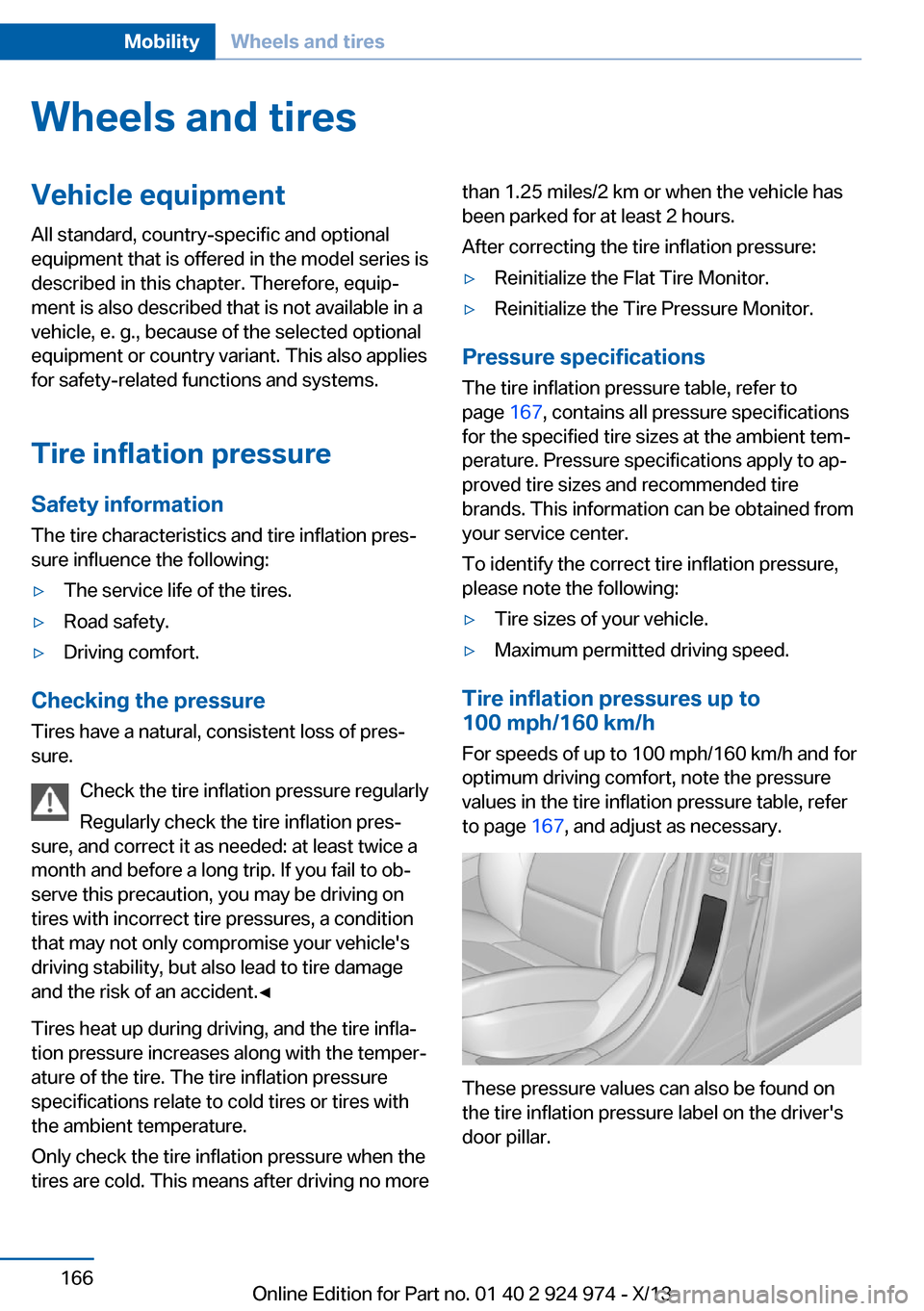
Wheels and tiresVehicle equipment
All standard, country-specific and optional
equipment that is offered in the model series is
described in this chapter. Therefore, equip‐
ment is also described that is not available in a
vehicle, e. g., because of the selected optional
equipment or country variant. This also applies
for safety-related functions and systems.
Tire inflation pressure Safety information
The tire characteristics and tire inflation pres‐
sure influence the following:▷The service life of the tires.▷Road safety.▷Driving comfort.
Checking the pressure
Tires have a natural, consistent loss of pres‐
sure.
Check the tire inflation pressure regularly
Regularly check the tire inflation pres‐
sure, and correct it as needed: at least twice a
month and before a long trip. If you fail to ob‐
serve this precaution, you may be driving on
tires with incorrect tire pressures, a condition
that may not only compromise your vehicle's
driving stability, but also lead to tire damage
and the risk of an accident.◀
Tires heat up during driving, and the tire infla‐
tion pressure increases along with the temper‐
ature of the tire. The tire inflation pressure
specifications relate to cold tires or tires with
the ambient temperature.
Only check the tire inflation pressure when the
tires are cold. This means after driving no more
than 1.25 miles/2 km or when the vehicle has
been parked for at least 2 hours.
After correcting the tire inflation pressure:▷Reinitialize the Flat Tire Monitor.▷Reinitialize the Tire Pressure Monitor.
Pressure specifications The tire inflation pressure table, refer to
page 167, contains all pressure specifications
for the specified tire sizes at the ambient tem‐
perature. Pressure specifications apply to ap‐
proved tire sizes and recommended tire
brands. This information can be obtained from
your service center.
To identify the correct tire inflation pressure,
please note the following:
▷Tire sizes of your vehicle.▷Maximum permitted driving speed.
Tire inflation pressures up to
100 mph/160 km/h
For speeds of up to 100 mph/160 km/h and for
optimum driving comfort, note the pressure
values in the tire inflation pressure table, refer
to page 167, and adjust as necessary.
These pressure values can also be found on
the tire inflation pressure label on the driver's
door pillar.
Seite 166MobilityWheels and tires166
Online Edition for Part no. 01 40 2 924 974 - X/13
Page 167 of 218
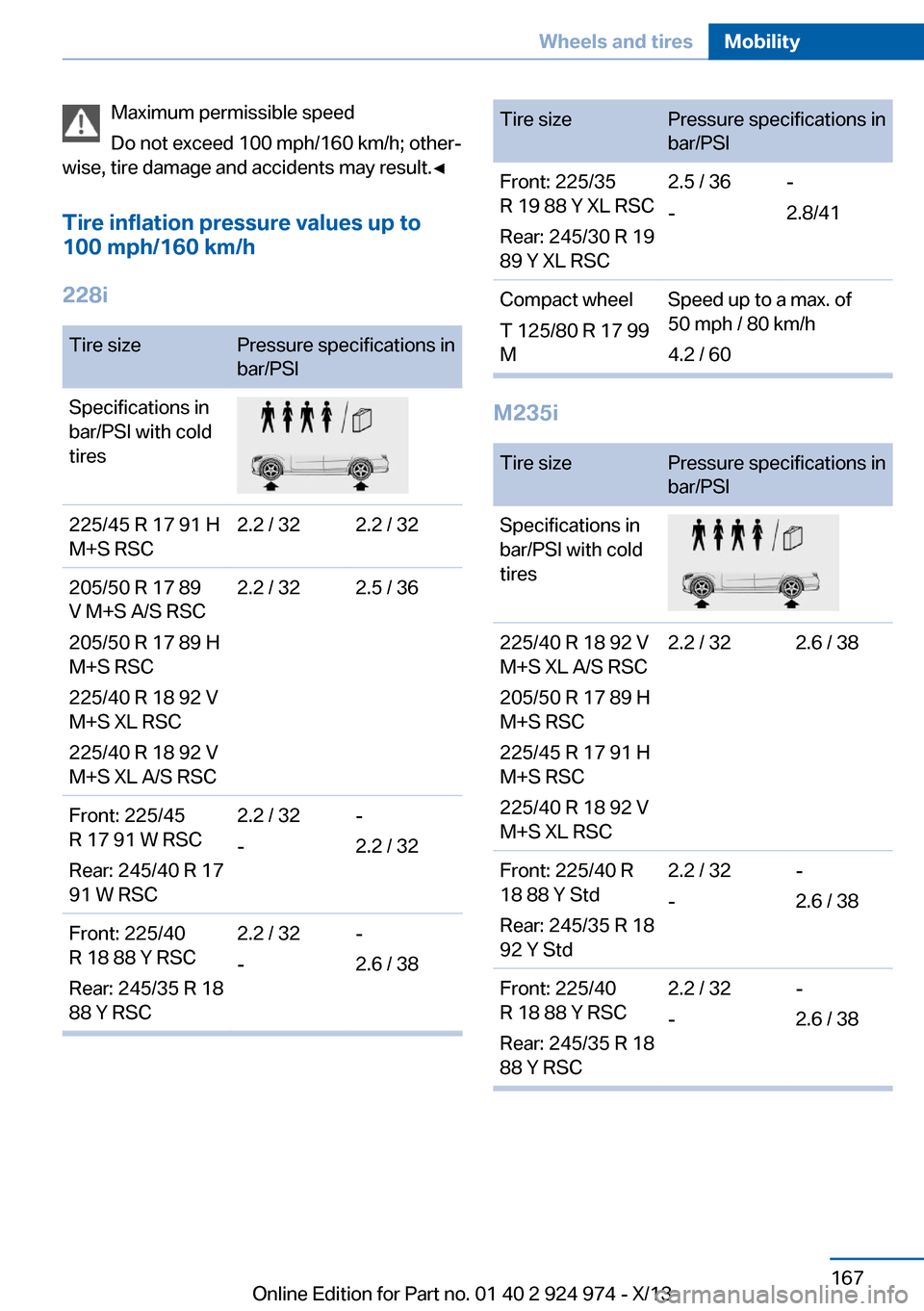
Maximum permissible speed
Do not exceed 100 mph/160 km/h; other‐
wise, tire damage and accidents may result.◀
Tire inflation pressure values up to
100 mph/160 km/h
228iTire sizePressure specifications in
bar/PSISpecifications in
bar/PSI with cold
tires225/45 R 17 91 H
M+S RSC2.2 / 322.2 / 32205/50 R 17 89
V M+S A/S RSC
205/50 R 17 89 H
M+S RSC
225/40 R 18 92 V
M+S XL RSC
225/40 R 18 92 V
M+S XL A/S RSC2.2 / 322.5 / 36Front: 225/45
R 17 91 W RSC
Rear: 245/40 R 17
91 W RSC2.2 / 32
--
2.2 / 32Front: 225/40
R 18 88 Y RSC
Rear: 245/35 R 18
88 Y RSC2.2 / 32
--
2.6 / 38Tire sizePressure specifications in
bar/PSIFront: 225/35
R 19 88 Y XL RSC
Rear: 245/30 R 19
89 Y XL RSC2.5 / 36
--
2.8/41Compact wheel
T 125/80 R 17 99
MSpeed up to a max. of
50 mph / 80 km/h
4.2 / 60
M235i
Tire sizePressure specifications in
bar/PSISpecifications in
bar/PSI with cold
tires225/40 R 18 92 V
M+S XL A/S RSC
205/50 R 17 89 H
M+S RSC
225/45 R 17 91 H
M+S RSC
225/40 R 18 92 V
M+S XL RSC2.2 / 322.6 / 38Front: 225/40 R
18 88 Y Std
Rear: 245/35 R 18
92 Y Std2.2 / 32
--
2.6 / 38Front: 225/40
R 18 88 Y RSC
Rear: 245/35 R 18
88 Y RSC2.2 / 32
--
2.6 / 38Seite 167Wheels and tiresMobility167
Online Edition for Part no. 01 40 2 924 974 - X/13
Page 168 of 218
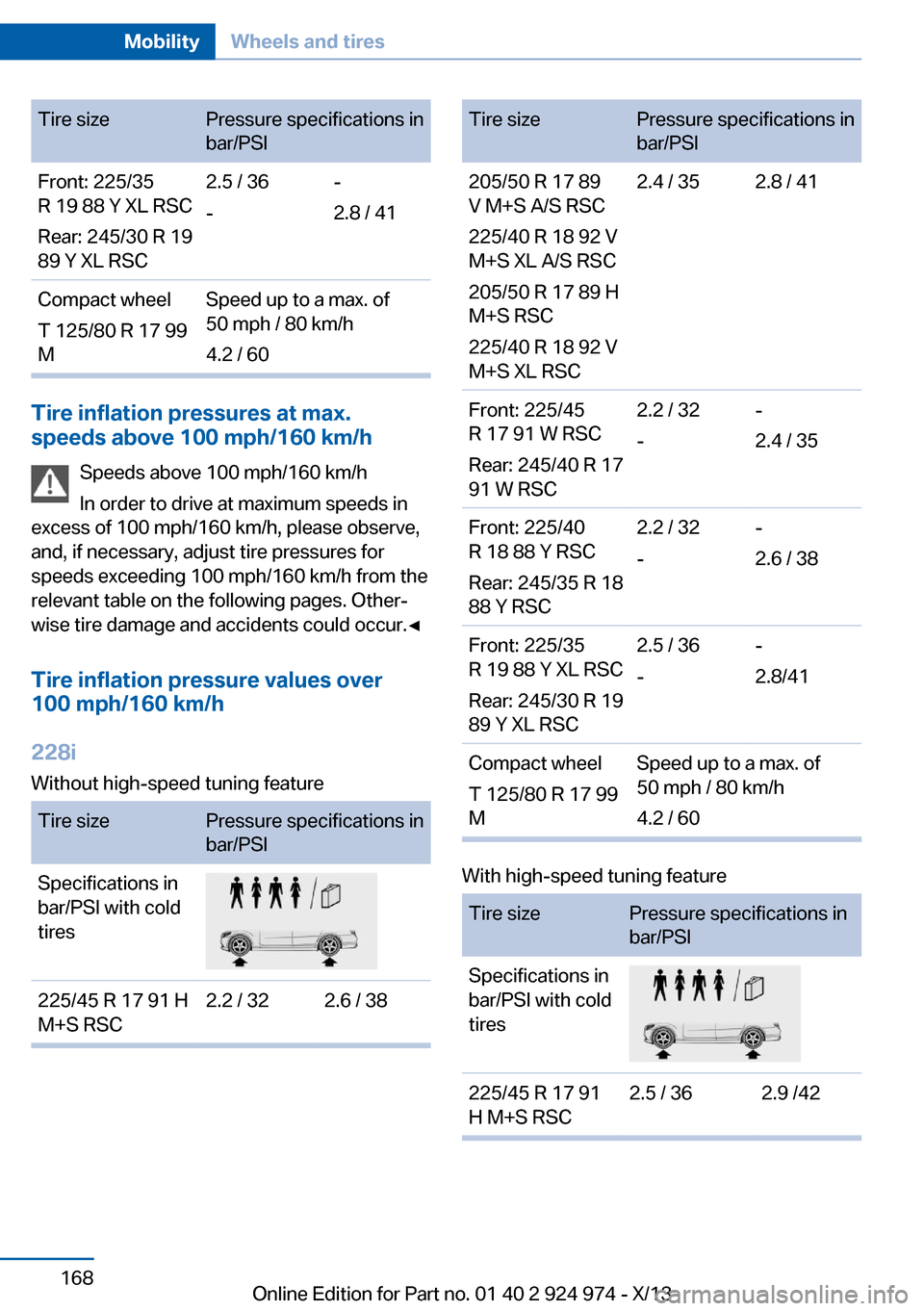
Tire sizePressure specifications in
bar/PSIFront: 225/35
R 19 88 Y XL RSC
Rear: 245/30 R 19
89 Y XL RSC2.5 / 36
--
2.8 / 41Compact wheel
T 125/80 R 17 99
MSpeed up to a max. of
50 mph / 80 km/h
4.2 / 60
Tire inflation pressures at max.
speeds above 100 mph/160 km/h
Speeds above 100 mph/160 km/h
In order to drive at maximum speeds in
excess of 100 mph/160 km/h, please observe,
and, if necessary, adjust tire pressures for
speeds exceeding 100 mph/160 km/h from the
relevant table on the following pages. Other‐
wise tire damage and accidents could occur.◀
Tire inflation pressure values over
100 mph/160 km/h
228i
Without high-speed tuning feature
Tire sizePressure specifications in
bar/PSISpecifications in
bar/PSI with cold
tires225/45 R 17 91 H
M+S RSC2.2 / 322.6 / 38Tire sizePressure specifications in
bar/PSI205/50 R 17 89
V M+S A/S RSC
225/40 R 18 92 V
M+S XL A/S RSC
205/50 R 17 89 H
M+S RSC
225/40 R 18 92 V
M+S XL RSC2.4 / 352.8 / 41Front: 225/45
R 17 91 W RSC
Rear: 245/40 R 17
91 W RSC2.2 / 32
--
2.4 / 35Front: 225/40
R 18 88 Y RSC
Rear: 245/35 R 18
88 Y RSC2.2 / 32
--
2.6 / 38Front: 225/35
R 19 88 Y XL RSC
Rear: 245/30 R 19
89 Y XL RSC2.5 / 36
--
2.8/41Compact wheel
T 125/80 R 17 99
MSpeed up to a max. of
50 mph / 80 km/h
4.2 / 60
With high-speed tuning feature
Tire sizePressure specifications in
bar/PSISpecifications in
bar/PSI with cold
tires225/45 R 17 91
H M+S RSC2.5 / 362.9 /42Seite 168MobilityWheels and tires168
Online Edition for Part no. 01 40 2 924 974 - X/13
Page 169 of 218
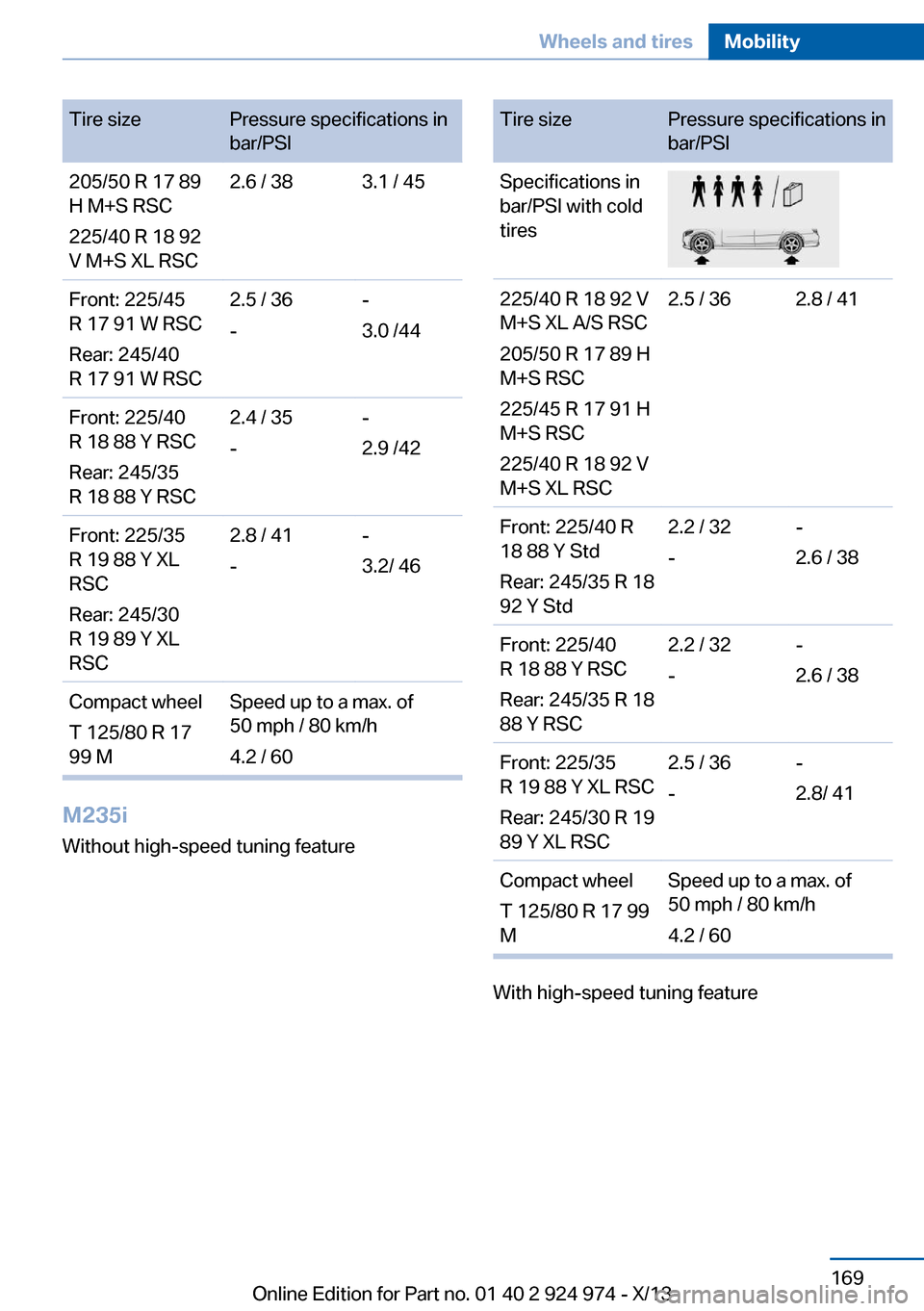
Tire sizePressure specifications in
bar/PSI205/50 R 17 89
H M+S RSC
225/40 R 18 92
V M+S XL RSC2.6 / 383.1 / 45Front: 225/45
R 17 91 W RSC
Rear: 245/40
R 17 91 W RSC2.5 / 36
--
3.0 /44Front: 225/40
R 18 88 Y RSC
Rear: 245/35
R 18 88 Y RSC2.4 / 35
--
2.9 /42Front: 225/35
R 19 88 Y XL
RSC
Rear: 245/30
R 19 89 Y XL
RSC2.8 / 41
--
3.2/ 46Compact wheel
T 125/80 R 17
99 MSpeed up to a max. of
50 mph / 80 km/h
4.2 / 60
M235i Without high-speed tuning feature
Tire sizePressure specifications in
bar/PSISpecifications in
bar/PSI with cold
tires225/40 R 18 92 V
M+S XL A/S RSC
205/50 R 17 89 H
M+S RSC
225/45 R 17 91 H
M+S RSC
225/40 R 18 92 V
M+S XL RSC2.5 / 362.8 / 41Front: 225/40 R
18 88 Y Std
Rear: 245/35 R 18
92 Y Std2.2 / 32
--
2.6 / 38Front: 225/40
R 18 88 Y RSC
Rear: 245/35 R 18
88 Y RSC2.2 / 32
--
2.6 / 38Front: 225/35
R 19 88 Y XL RSC
Rear: 245/30 R 19
89 Y XL RSC2.5 / 36
--
2.8/ 41Compact wheel
T 125/80 R 17 99
MSpeed up to a max. of
50 mph / 80 km/h
4.2 / 60
With high-speed tuning feature
Seite 169Wheels and tiresMobility169
Online Edition for Part no. 01 40 2 924 974 - X/13
Page 170 of 218

Tire sizePressure specifications in
bar/PSISpecifications in
bar/PSI with cold
tires205/50 R 17 89 H
M+S RSC
225/45 R 17 91 H
M+S RSC
225/40 R 18 92 V
M+S XL RSC2.7 / 393.1 / 45Front: 225/40 R
18 88 Y Std
Rear: 245/35 R
18 92 Y Std2.5 / 36
--
2.9 / 42Front: 225/40
R 18 88 Y RSC
Rear: 245/35
R 18 88 Y RSC2.5 / 36
--
2.9 / 42Front: 225/35
R 19 88 Y XL
RSC
Rear: 245/30
R 19 89 Y XL
RSC2.9 /42
--
3.2/ 46Compact wheel
T 125/80 R 17 99
MSpeed up to a max. of
50 mph / 80 km/h
4.2 / 60
Tire identification marks
Tire size 245/45 R 18 96 Y
245: nominal width in mm
45: aspect ratio in %
R: radial tire code
18: rim diameter in inches
96: load rating, not for ZR tires
Y: speed rating, before the R on ZR tires
Speed letter
Q = up to 100 mph, 160 km/h
R = up to 106 mph, 170 km/h
S = up to 112 mph, 180 km/h
T = up to 118 mph, 190 km/h
H = up to 131 mph, 210 km/h
V = up to 150 mph, 240 km/h
W = up to 167 mph, 270 km/h
Y = up to 186 mph, 300 km/h
Tire Identification Number
DOT code: DOT xxxx xxx 1013
xxxx: manufacturer code for the tire brand
xxx: tire size and tire design
1013: tire age
Tires with DOT codes meet the guidelines of
the U.S. Department of Transportation.
Tire age
DOT … 1013: the tire was manufactured in the
10th week 2013.
Recommendation
Regardless of wear, replace tires at least every
6 years.
Uniform Tire Quality GradingQuality grades can be found where applicable
on the tire sidewall between tread shoulder
and maximum section width.
For example: Treadwear 200; Traction AA;
Temperature A
DOT Quality Grades Treadwear
Traction AA A B C
Temperature A B CSeite 170MobilityWheels and tires170
Online Edition for Part no. 01 40 2 924 974 - X/13
Page 174 of 218
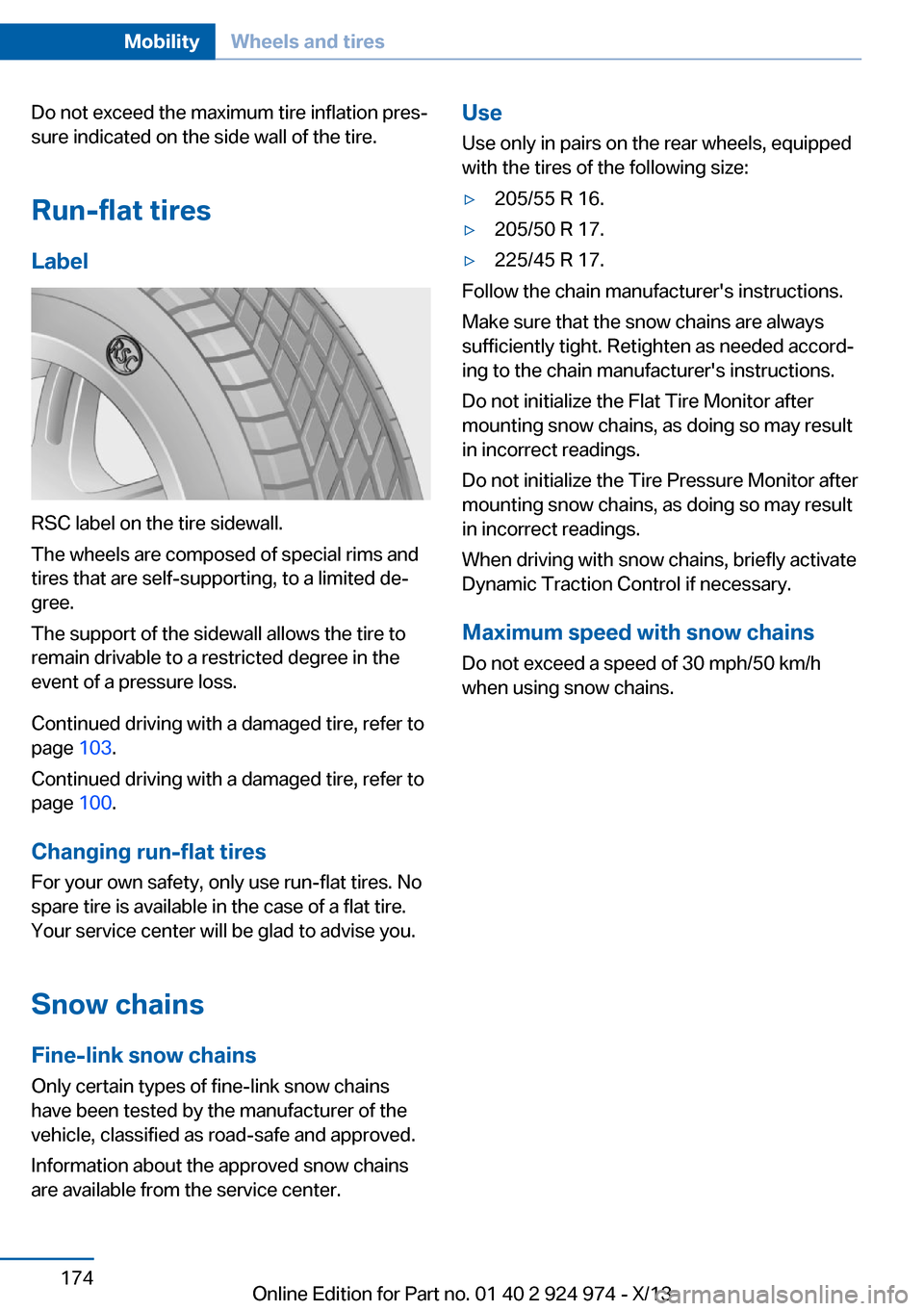
Do not exceed the maximum tire inflation pres‐
sure indicated on the side wall of the tire.
Run-flat tires
Label
RSC label on the tire sidewall.
The wheels are composed of special rims and
tires that are self-supporting, to a limited de‐
gree.
The support of the sidewall allows the tire to
remain drivable to a restricted degree in the
event of a pressure loss.
Continued driving with a damaged tire, refer to
page 103.
Continued driving with a damaged tire, refer to
page 100.
Changing run-flat tires
For your own safety, only use run-flat tires. No
spare tire is available in the case of a flat tire.
Your service center will be glad to advise you.
Snow chains
Fine-link snow chains
Only certain types of fine-link snow chains
have been tested by the manufacturer of the
vehicle, classified as road-safe and approved.
Information about the approved snow chains
are available from the service center.
Use
Use only in pairs on the rear wheels, equipped
with the tires of the following size:▷205/55 R 16.▷205/50 R 17.▷225/45 R 17.
Follow the chain manufacturer's instructions.
Make sure that the snow chains are always
sufficiently tight. Retighten as needed accord‐
ing to the chain manufacturer's instructions.
Do not initialize the Flat Tire Monitor after
mounting snow chains, as doing so may result
in incorrect readings.
Do not initialize the Tire Pressure Monitor after
mounting snow chains, as doing so may result
in incorrect readings.
When driving with snow chains, briefly activate
Dynamic Traction Control if necessary.
Maximum speed with snow chains Do not exceed a speed of 30 mph/50 km/h
when using snow chains.
Seite 174MobilityWheels and tires174
Online Edition for Part no. 01 40 2 924 974 - X/13